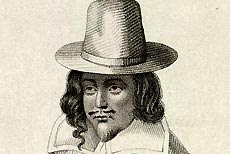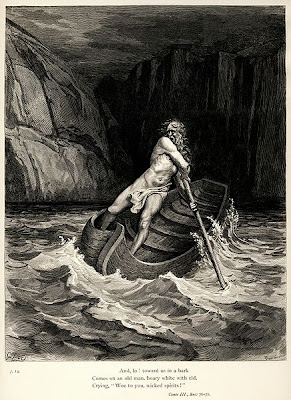This loathsome soul is Matthew Hopkins,the self styled Witch Finder General.
Matthew Hopkins, born in
Grantham,
Lincolnshire, was one of six children born to James Hopkins, a Puritan
clergyman, vicar of
Wenham, in Suffolk.
Because of the way he presented evidence in trials, Hopkins is commonly thought to have been trained as a
lawyer but there is scant evidence to suggest this was the case.
According to his book
The Discovery of Witches, he began his career as a witch-finder when he claimed to have overheard various women discussing their meetings with the
Devil in March 1644 in
Manningtree, a town near
Colchester, where he was living at the time.
In fact the first accusations were made by
John Stearne
and Hopkins was appointed as his assistant. As a result of the
accusations, nineteen convicted witches were hanged and four of the
accused died in prison.
Hopkins and Stearne, accompanied by the women who performed the
pricking, were soon travelling over eastern England, claiming to be officially commissioned by
Parliament
to uncover and prosecute witches.
Parliament was well aware of his and
his team's activities, as shown by the concerned reports of the
Bury St Edmunds witch trials of 1645.
His witch-finding career spanned from 1645 to 1647. While
torture
was technically unlawful in England, he used various methods of
browbeating to extract confessions from some of his victims.
He used
sleep deprivation
as a sort of bloodless torture. Another one of his methods was to first
search for the Devil's mark on a woman; this would be a boil. If she
had a familiar (cat or dog) he would suspect that the familiar was
sucking the woman's blood.
This boil would be known as the third
nipple. Then he would cut her arm with a blunt knife and if she did not
bleed she was a witch. He also used a "swimming" test to see if the
accused would float or sink in holy water, the theory being that
witches had renounced their
baptism,
so that all holy water would reject them.
He also employed "witch
prickers" who pricked the accused with knives and special needles,
looking for the
Devil's mark (a mole or
birthmark) that was supposed to be dead to all feeling and would not bleed. It was believed that the witch's
familiar would drink their blood from the mark as milk from a teat.
Hopkins and his colleague John Stearne, together with their female assistants, were well paid for their work.
Samuel Butler's
satire Hudibras commented on Hopkins's activity, saying:
- Has not this present Parliament
- A Lieger to the Devil sent,
- Fully impowr'd to treat about
- Finding revolted witches out
- And has not he, within a year,
- Hang'd threescore of 'em in one shire?
- Some only for not being drowned,
- And some for sitting above ground,
- Whole days and nights, upon their breeches,
- And feeling pain, were hang'd for witches.
- And some for putting knavish tricks
- Upon green geese and turky-chicks?
- And pigs, that suddenly deceast
- Of griefs unnat'ral, as he guest;
- Who after prov'd himself a witch
- And made a rod for his own breech.
The last line refers to a tradition that disgruntled villagers
caught Hopkins and subjected him to his own "swimming" test: he
floated, and it was therefore suspected that he was hanged for
witchcraft himself but, no evidence of this ever happening exists.
Most
historians believe that Hopkins died of illness, possibly
tuberculosis, in his home. The parish records of
Manningtree in Essex record his burial on 12 August 1647.
h/t wiki.
"What else is woman but a foe to friendship, an inescapable punishment,
a necessary evil, a natural temptation, a desirable calamity, a
domestic danger, a delectable detriment, an evil of nature, painted in
fair colors..¨
The word woman is used to mean the lust of the flesh, as
it is said¨ I have found a woman more bitter than death, and a good
woman more subject to carnal lust...Women are naturally more
impressionable...Women are intellectually like children...She is more
carnal than a man, as is clear from her many carnal
abominations...Therefore a wicked woman is by her nature quicker to
waver in her faith, and consequently quicker to abjure the faith, which
is the root of witchcraft..."
- Malleus Maleficarum
The
"Malleus Maleficarum" was written by
Heinrich Kramer and
Jacob
Sprenger in 1486. Sprenger and Kramer were both members of the
Dominican Order and were Inquisitors for the Catholic Church’s
inquisition against heretics. Heresy in this sense was an error in
understanding and of faith in the Catholic religion, ultimately
discernible by God alone.
On December 5, 1484 Pope Innocent VIII had issued the famous
"witch-bull" to Kramer and Sprenger in response to their asking for
explicit authority to prosecute witchcraft. This papal bull would be
used as the preface for the "Malleus Maleficarum." The Summis
desiderantes affectibus recognized the existence of witches and gave
full papal approval for the Inquisition against witches and gave
permission to do whatever necessary to get rid of them, thus opening
the door for the bloody witch hunts that ensued for centuries.
During the ensuing "burning times," approximately 40,000 executions
occured over 250 years in Europe, the largest quantity of which
occurred in Germany. One small town in Germany lost their entire female
population to the flames.
In Wurzburg, a series of burnings claimed a horrific list of victims, none of whose names survive:
"Three play-actors".
"Four innkeepers".
"Three common councilmen of Wurszburg".
"Fourteen vicars of the Cathedral".
"The burgomasters lady" (The wife of the mayor).
"The apothecarys wife and daughter".
"Two choristers of the cathedral".
Gobel Babelin, "The prettiest girl in town".
"The wife, the two little sons and the daughter of councillor Stolzenberg."
Baunach, "The fattest burgher (merchant) in Wurzburg".
Steinacher, "The richest burgher in Wurzburg".
The Seventh burning
"A wandering boy, twelve years of age".
"Four strange men and women, found sleeping in the market-place".
The thirteenth/fourteenth burning
" A little maiden nine years of age".
" A maiden still less (than nine)".
" Her (The little girl's) sister, their mother and their aunt".
" A pretty young woman of twenty-four".
The eighteenth burning
"Two boys of twelve".
"A girl of fifteen".
The nineteenth burning
" The young heir of the house of Rotenhahn", aged nine.
A boy of ten.
A boy, twelve years old.
Although most heretics were women, a great many men were also taken,
tortured, and put to death. This is a letter from one such victim at
the notorious Bamberg in Germany; a poignant epitaph to one of Europe's
most hideous crimes:
"Many hundred thousand good-nights, dearly beloved daughter Veronica.
Innocent have I come into prison, innocent have I been tortured,
innocent must I die. For whoever comes into the witch prison must
become a witch or be tortured until he invents something out of his
head - and God pity him - bethinks him of something."
"And then came also - God in highest heaven have mercy - the
executioner, and put the thumbscrews on me, both hands bound together,
so that the blood spurted from the nails and everywhere, so that for
four weeks I could not use my hands, as you can see from my writing.
Thereafter they stripped me, bound my hands behind me, and drew me up
on the ladder. Then I thought heaven and earth were at an end. Eight
times did they draw me up and let me fall again, so that I suffered
terrible agony."
The author of this letter,
Johannes Junius, did indeed confess to being
a witch, and in August of 1628, was burned at the stake. He managed to
send his final letter to his daughter, which ended by saying:
"Dear child, keep this letter secret, so that people do not find it,
else I shall be tortured most piteously and the jailers will be
beheaded. So strictly is it forbidden...Dear child, pay this man a
thaler...I have taken several days to write this - my hands are both
crippled. I am in a sad plight. Good night, for your father Johannes
Junius will never see you more."
I think todays Pope and every Pope after owes the poor souls all over the world who were {and still are} tortured and murdered on the orders of Pope Innocent V111 an apology .....don`t you?..don`t hold your breath.
Pope Innocent V111...what an utter merciless bastard.Don`t you just love Christianity.
I think i can guess where his soul resides now.
May he rot!
Finally be ye all of one mind,having compassion one of another,love as brethren,be pitiful,be courteous.
Peter 3:8


















